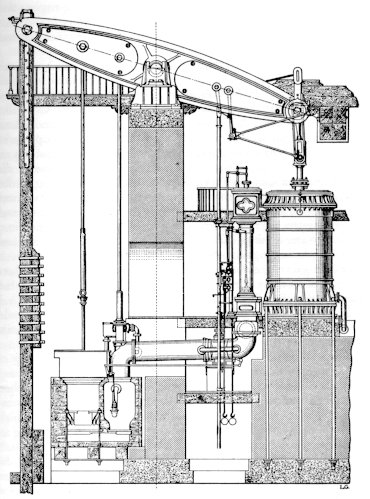Cornwall West
Today, a story about adaptation. The University of Houston's College of Engineering presents this series about the machines that make our civilization run, and the people whose ingenuity created them.
The first miners who stepped into our great forbidding West weren't after gold. They were after more useful metals -- tin and copper. Gold didn't turn up in California until 1848. But miners had already crossed the Mississippi by 1840.
Mining was terrible, hard, and dangerous work. It took people as tough as they were smart. Our first Western miners came out of the mines of Cornwall. Then laborers, driven from Ireland by the potato famine, joined them. They went into Colorado, Nevada, Arizona, California. They brought along their old methods and their old Catholic/Protestant hatreds.
At first, Cornishmen and Irishmen wrecked whole mining camps when they got drunk and went at each other. Later they adapted. They learned to join each other's fun on St. George's and St. Patrick's day.
But, if you watched the old Poldark series on Masterpiece Theatre, you caught a glimpse of the highly honed Cornish mining technology. That same expertise was still taking ore out of the American West in this century.
Ground water is the worst problem in shaft mining. A deep mine is a lot like a well. You have to take water out constantly. The English started doing that with Newcomen's steam engine in 1712. Out of that came the Cornish pump.
By the late 1700s those huge walking-beam engines dotted Cornwall. They took on only the first of Watt's steam-engine improvements. From then on, the Cornish pump was a technology frozen in time -- frozen in 1769.
And what a great lumbering dinosaur it was! Around 1800, Erasmus Darwin, poet and friend of James Watt, wrote about one:
Press'd by the ponderous air the Piston falls
Resistless, sliding through its iron walls;
Quick moves the Balanced beam, of giant-birth,
Wields his large limbs, and nodding shakes the earth.
Now Cornish miners adapted Cornish pumps to the American West. Here's a photo of one in Tombstone, Arizona. Someone took it in the 1890s. A great iron beam, 3 stories high, drives a rod down -- into the earth. It powers stage after stage of pumps, hundreds of feet below. It empties tons of water a minute. Yet it's still a machine from 1769 -- still frozen in time.
The old Cornish pump, like the Cornish miners who came here, had stunning adaptability. The Cornish pump was simple and rugged -- a perfect fit to its purpose. It was like the DC-3, the violin, or silverware. It was a machine so well conceived that it outlived competition. It even outlived improvement.
I'm John Lienhard, at the University of Houston, where we're interested in the way inventive minds work.
(Theme music)
Young, Otis E., Jr., Black Powder and Hand Steel: Miners and Machines on the Old Western Frontier. Norman, Oklahoma: University of Oklahoma Press, 1975.

A late 19th-century drawing of a Cornish engine